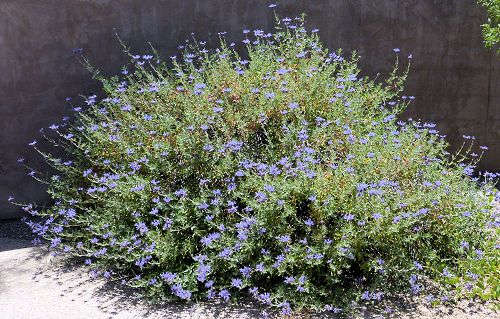Growing Salvia clevelandii:
Cleveland Sage
Description
Form: Herbaceous stems, becoming partly woody from the bottom up with age, growing from a woody base (subshrub).
Lifespan: Perennial.
Leaf retention: Frost and drought deciduous.
Growth rate: Rapid.
Mature Size: 5' (1.5m) high by 6' (1.8m) wide.
Flowers: Blue trumpet-shaped flowers clustered on the ends of branches.
Bloom: The fullest bloom is in the spring, with sporadic blooms the rest of the year.
Fruit: Up to four tiny seeds at the base of each dried flower. The seed heads persist on the plant after flowering.
Leaves: Gray-green, rough texture, strongly aromatic.
Stems: Square in cross-section, new stems are herbaceous, red or purple, and grow partly woody from the bottom up with age. Stems on the ground may grow roots from nodes.
Wildlife: The flowers attract bees, sphinx moths, and hummingbirds.
Toxic / Danger: No.
Origin: The coast of California and Baja California, Mexico.
Form: Herbaceous stems, becoming partly woody from the bottom up with age, growing from a woody base (subshrub).
Lifespan: Perennial.
Leaf retention: Frost and drought deciduous.
Growth rate: Rapid.
Mature Size: 5' (1.5m) high by 6' (1.8m) wide.
Flowers: Blue trumpet-shaped flowers clustered on the ends of branches.
Bloom: The fullest bloom is in the spring, with sporadic blooms the rest of the year.
Fruit: Up to four tiny seeds at the base of each dried flower. The seed heads persist on the plant after flowering.
Leaves: Gray-green, rough texture, strongly aromatic.
Stems: Square in cross-section, new stems are herbaceous, red or purple, and grow partly woody from the bottom up with age. Stems on the ground may grow roots from nodes.
Wildlife: The flowers attract bees, sphinx moths, and hummingbirds.
Toxic / Danger: No.
Origin: The coast of California and Baja California, Mexico.
Cultivation and Uses
USDA hardiness zones: 8b-10.
Heat tolerant: Part shade is needed in high temperatures.
Drought tolerant: Yes.
Sun: All day part shade in the hottest months of the year.
Soil: Well draining, pH 6.1-7.8 (slightly acidic to slightly alkaline).
Water once established: Once or twice a month.
Mulch: Use organic mulch over the root area in regions with winter freezes.
Prune: Not necessary. If reducing the plant's size is desirable, cut one-third of the stem off in winter. The dried seed heads can be removed anytime.
Litter: Low.
Propagation: Seed or cuttings.
Uses: Ornamental, fragrance garden. For some cultivars, the aroma extends 6-10' (1.8-3m) from the plant. Not everyone will find this aroma appealing. The leaves can be a substitute for culinary sage in cooking, but have a very strong flavor and must be used sparingly. For a list of culinary sage plants, see Low Water Culinary Herbs.
USDA hardiness zones: 8b-10.
Heat tolerant: Part shade is needed in high temperatures.
Drought tolerant: Yes.
Sun: All day part shade in the hottest months of the year.
Soil: Well draining, pH 6.1-7.8 (slightly acidic to slightly alkaline).
Water once established: Once or twice a month.
Mulch: Use organic mulch over the root area in regions with winter freezes.
Prune: Not necessary. If reducing the plant's size is desirable, cut one-third of the stem off in winter. The dried seed heads can be removed anytime.
Litter: Low.
Propagation: Seed or cuttings.
Uses: Ornamental, fragrance garden. For some cultivars, the aroma extends 6-10' (1.8-3m) from the plant. Not everyone will find this aroma appealing. The leaves can be a substitute for culinary sage in cooking, but have a very strong flavor and must be used sparingly. For a list of culinary sage plants, see Low Water Culinary Herbs.
Comments
This plant is a member of the Mint family (Lamiaceae). Other common names are Chaparral Sage and California Blue Sage. Several cultivars are available, including 'Winnifred Gilman'.
Do you have additional information or a different experience for these plants that you would like to share? Email info@GardenOracle.com. All contributions are welcome and appreciated.
This plant is a member of the Mint family (Lamiaceae). Other common names are Chaparral Sage and California Blue Sage. Several cultivars are available, including 'Winnifred Gilman'.
Do you have additional information or a different experience for these plants that you would like to share? Email info@GardenOracle.com. All contributions are welcome and appreciated.


Latest update: September, 2024
© 2008-2025 by GardenOracle.com

